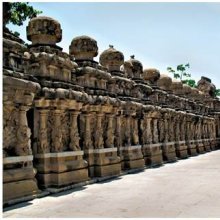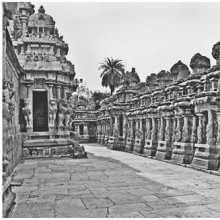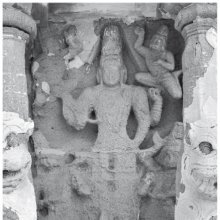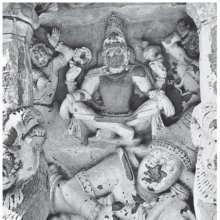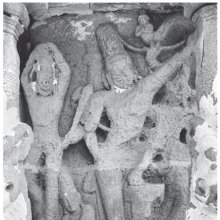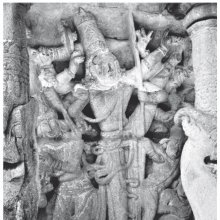Surrounding: 2 definitions
Introduction:
Surrounding means something in Hinduism, Sanskrit, the history of ancient India. If you want to know the exact meaning, history, etymology or English translation of this term then check out the descriptions on this page. Add your comment or reference to a book if you want to contribute to this summary article.
Images (photo gallery)
(+80 more images available)
In Hinduism
Shilpashastra (iconography)
Source: Shodhganga: Elements of Art and Architecture in the Trtiyakhanda of the Visnudharmottarapurana (shilpa)The Surroundings play a strong role in the conceptualisation of an idea by a painter, in the tradition of ancient Indian Painting (citra), according to the Viṣṇudharmottarapurāṇa, an ancient Sanskrit text which (being encyclopedic in nature) deals with a variety of cultural topics such as arts, architecture, music, grammar and astronomy.—From the ancient period till today, many natural objects like trees, flowers, leaves, forests, mountains, sun, moon etc. and natural phenomenon like day and night, the seasons, rain etc. always seem to inspire the artist to make beautiful creations. Even the sages in the Vedic period used to see the surroundings and could visualise everything as portraits in the mind. That is why the sages are called the seers but not doer—ṛṣi darśanāt. So, surroundings and the objects in the surroundings always play a strong role in the conceptualisation of an idea by a painter or an artist.

Shilpashastra (शिल्पशास्त्र, śilpaśāstra) represents the ancient Indian science (shastra) of creative arts (shilpa) such as sculpture, iconography and painting. Closely related to Vastushastra (architecture), they often share the same literature.
India history and geography
Source: Singhi Jain Series: Ratnaprabha-suri’s Kuvalayamala-katha (history)Surroundings refers to a particular element of a (composite) painting, according to the rules of Citrasūtra and the Kathās (narrative poems) such as Uddyotanasūri in his 8th-century Kuvalayamālā (a Prakrit Campū, similar to Kāvya poetry).—Page 233.7: There is a mention of a young painter bringing a cloth-painting on which was depicted the portrait of the daughter of the king of Ujjayinī. The painting was marked with the purity of lines, richness of colours, according to different compositions, beautiful stripling or seedling to show the effect of surroundings or high and low surfaces and right measurements and representation of different lines of painting like sādṛśya. [...]

The history of India traces the identification of countries, villages, towns and other regions of India, as well as mythology, zoology, royal dynasties, rulers, tribes, local festivities and traditions and regional languages. Ancient India enjoyed religious freedom and encourages the path of Dharma, a concept common to Buddhism, Hinduism, and Jainism.
See also (Relevant definitions)
Full-text (+1112): Prakara, Pariveshtana, Parivesana, Parikshepa, Parishthala, Parigama, Paryavashtambhana, Avakunthana, Parivesha, Parikriya, Veshta, Veshtana, Jambudvipa, Udveshtana, Udveshta, Parikalayitri, Parisarpa, Lokaloka, Pariveshtita, Prasarani.
Relevant text
Search found 289 books and stories containing Surrounding; (plurals include: Surroundings). You can also click to the full overview containing English textual excerpts. Below are direct links for the most relevant articles:
Vastu-shastra (2): Town Planning (by D. N. Shukla)
Beautification (b): Gardens, etc. < [Chapter 6 - Deification and Beautification of Towns]
Preliminaries (b): Land and Landscape suited to an Ideal town < [Chapter 3 - Preliminaries of Town Planning]
Preliminaries (a): Regional Planning < [Chapter 3 - Preliminaries of Town Planning]
The Tattvasangraha [with commentary] (by Ganganatha Jha)
Verse 1990-1992 < [Chapter 23 - External World]
Chaitanya Bhagavata (by Bhumipati Dāsa)
Introduction to chapter 7 < [Chapter 7 - The Meeting of Gadādhara and Puṇḍarīka]
Verse 3.9.236 < [Chapter 9 - The Glories of Advaita]
Verse 2.6.97 < [Chapter 6 - The Lord’s Meeting with Advaita Ācārya]
Lord Jhulelal: An Analytical Study (by Thakkar Harish Gopalji)
Part 2 - Lord Jhulelal's teachings to Ruler Mirkshah < [Chapter 4 - Analysis]
Part 28 - Literature Review: Zarathushtra by Kety K. Dady Burjor < [Chapter 2 - Literature Review]
Part 16 - Agriculture < [Chapter 2 - Literature Review]
Parables of Rama (by Swami Rama Tirtha)
Story 38 - The Darkness of Ignorance < [Chapter VI - Ignorance]
Story 85 - Difficulties Unavoidable < [Chapter XII - Obstacles]
Story 58 - Law of love < [Chapter IX - Love]
William Wordsworth The Environmentalist < [April – June, 2003]
Reality of Life < [April – June, 2005]
Here Lay... < [January – March, 1987]
Related products
(+3 more products available)
